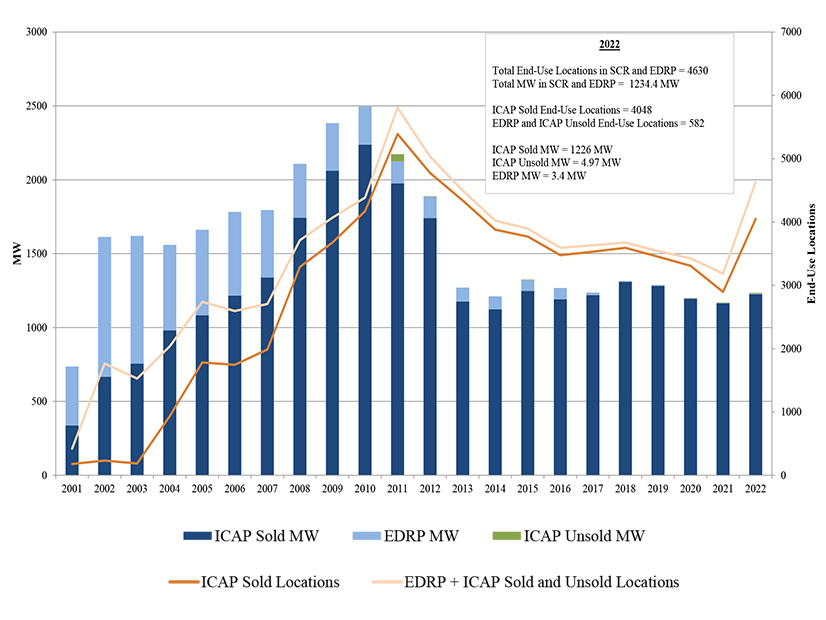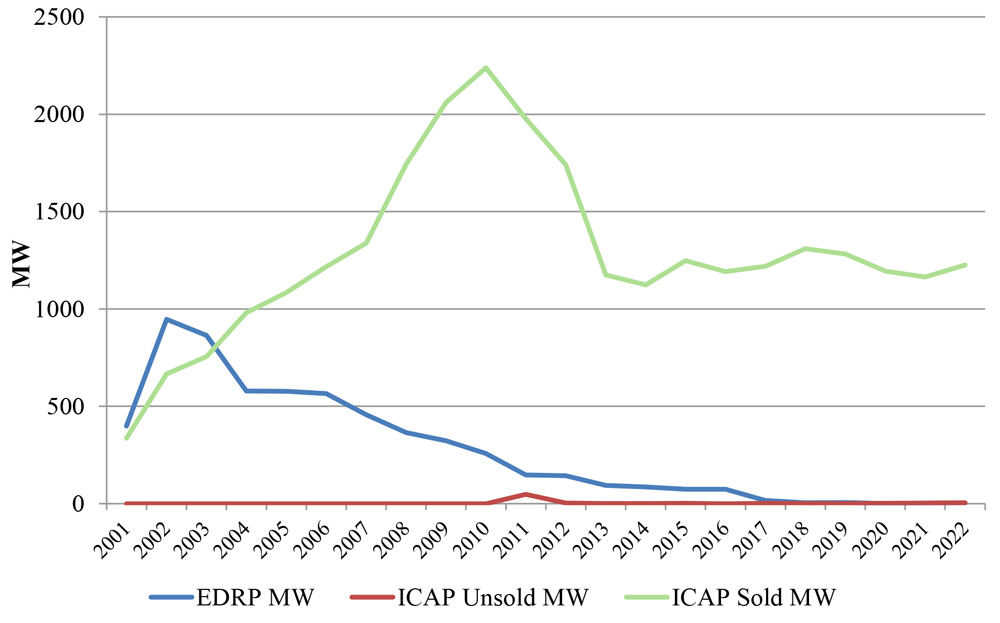NYISO stakeholders continued their criticism of the ISO’s effort to improve its demand response programs, saying its recent “issue discovery” report inadequately addressed their concerns and that its proposal to allow demand-side resources (DSRs) to participate in the day-ahead market is hollow.
During the Dec. 6 Installed Capacity/Market Issues Working Group (ICAP/MIWG) meeting, NYISO presented findings from its Engaging the Demand Side (EtDS) report, a response to stakeholders’ request that the ISO investigate whether rules could be improved to reflect DSR’s “evolved … capabilities while keeping participation options for these resources simple.”
The report recommended investigating a day-ahead-only addition to the DER participation model that it said could increase participation opportunities for DSRs that can operate for longer than the four hours required by the special case resource (SCR) program but cannot participate in the dispatchable DER model, which requires daily bidding and scheduling in the energy market. The report rejected requests to expand the SCR model.
Stakeholders representing demand response providers expressed reservations about the feasibility and cost implications of the proposals, repeating concerns expressed at previous meetings. (See Providers See ‘Mixed Signals’ on Demand Response in NYISO.)
“I am very disappointed in this report and the outcome of this yearlong process of analysis and engagement with the stakeholders,” said Amanda De Vito Trinsey, a partner at Couch White, representing the City of New York and large industrial, commercial and institutional energy consumers.
Jay Brew, managing director of Stone Mattheis Xenopoulos & Brew, who represents Nucor Steel Auburn, said he felt NYISO did not appreciate the risks their recommendations could pose to SCRs. “I’m generally disappointed with the level of effort here,” he said. “It would seem to me you’d want to be enhancing demand response as much as possible, particularly peak load response, as opposed to seeing the SCR program wither and die.”
SCRs are DSRs capable of being interrupted or curtailed by the ISO for at least four consecutive hours each day, and they act as installed capacity suppliers.
A DER can be a DSR, a generator or storage resource of 20 MW or less, or a facility of up to 20 MW composed of two or more technology types behind a single point of interconnection.
The report recommends exploring market rules that would enable SCRs to participate in the day-ahead market and allowing them to submit bids or receive schedules without re-evaluation in the real-time market. These DSRs could be able to register with energy durations of two, four, six or eight hours.
The ISO said it hasn’t decided whether day-ahead only DSRs should be allowed to aggregate, as dispatchable DER and SCRs can.
Telemetry
NYISO requires DER aggregations to provide telemetry on a six-second basis, or in real time for aggregations of at least 100 kW.
Stakeholders said this requirement could be financially burdensome, particularly for smaller SCRs.
Aaron Breidenbaugh, senior director of regulatory affairs at aggregator CPower Energy Management, said the proposal would be uneconomical for SCRs below 5 MW.
“We’ve seen the numbers for our customers that range between $10 [thousand] and $30,000 for telemetry,” he said.
“And certainly, the vast majority of existing SCR resources are below five MW.”
Breidenbaugh also questioned the ISO’s commitment to incorporating stakeholder input.
“I think [the report] is misrepresenting this concern. … The issue we have with respect to telemetry isn’t just for small customers, it is more pronounced with smaller customers, but this is a big barrier for all sizes,” Breidenbaugh said.
Expanded SCR Program Rejected
Stakeholders had urged expansion of the SCR program, saying many SCRs are now capable of operating for longer than the four-hour minimum requirement and can respond in less than the minimum 21-hour notice they now receive.
But ISO staff said the program requires extensive manual processes, making expansion impractical. Expanding the SCR model also would continue reliance on out-of-market actions, contrary to the need for more grid adaptability due to increased penetration of intermittent generating resources and storage, staff said.
Rules allowing SCRs to have multiple energy duration limits and startup/shutdown times would require the ISO “to call on them individually like DER,” staff said in the presentation. “NYISO would no longer be able to call SCRs to activate based on load zones.”
NYISO proposed using its existing DER participation model software instead of modifying the SCR program, saying it adds flexibility and cost efficiency to grid operations.
“Adding the stakeholder-requested flexibility to these processes is expected to affect the ability of NYISO grid operators to respond to system conditions quickly and efficiently,” the report said. “Making the requested modifications to the SCR program would require grid operators to understand the unique operating characteristics of individual SCRs to determine which resources are best positioned to respond to a given set of conditions.”
The ISO recommended maintaining the SCR program for the time being due to its simplicity, acknowledging that the DER model is more complex. “The NYISO does not intend to eliminate or modify the SCR model at this time, providing existing and future DSRs flexibility to choose the participation model that best fits their operating characteristics,” the report said.
ISO staff also rejected stakeholders’ request to eliminate the ISO’s proposed 10-kW minimum size for individual DER participation, which they have called discriminatory and counterproductive. (See Clean Energy Groups Protest NYISO DER Proposal.)
Staff said eliminating the threshold could significantly increase the number of small DER seeking to enter New York markets, increasing administrative costs. Staff also noted that software automation being developed for Order 2222 compliance that could help will not be in place until at least 2026.
Stakeholder Feedback
Stakeholders at the ICAP/MIWG meeting criticized the EtDS report, the ISO’s project prioritization process and what they called a lack of clarity on next steps.
De Vito Trinsey said the ISO was simply going through a “check the box” exercise rather than making a genuine effort to enhance demand-side participation.
Julia Popova, NRG Energy’s manager of regulatory affairs, concurred, questioning why ISO staff’s only recommendation was to explore the development of a day-ahead DER enhancement. “This issue seems to address only one issue among many that were raised [in previous conversation], so why was this the winning issue?” she asked.
Francesco Biancardi, a market design specialist with NYISO, responded, “We’re trying to find a path that both addresses external stakeholder feedback and addresses NYISO’s concerns regarding reliability and market efficiency. So a day-ahead demand response enhancement seemed like a good way to check all those boxes.”
De Vito Trinsey asked the ISO to explain why it hired a consultant to examine only small-scale residential DERs and not anything else within the demand-side program.
James Sweeney, a senior attorney with the ISO, responded that the consultant was hired because ISO staff did not have the bandwidth to study a group of resources that were not originally part of the EtDS project and which they were not experts in.
These specific concerns were compounded by stakeholders’ belief that the ISO failed to heed the warnings expressed previously.
“The assumption [from NYISO] is that moving demand response, particularly large customers, to the DER model will go smoothly,” Brew said, “and that seems to disregard the repeated comments that were raised by others regarding DER participation.”
Breidenbaugh had a similar view, saying, “If you’re holding [this day-ahead recommendation] as the principal outcome of this Engaging the Demand Side effort, you’re essentially ignoring all of the input that you got from stakeholders during this process.”



